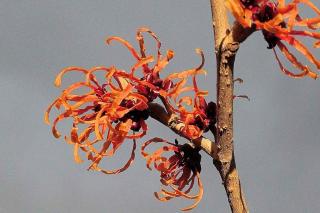

Often called winterbloom or hamamelis, witch-hazel is a plant for which the scientific name is Hamamelis virginiana
It is a shrub that belongs to the Hamamelidaceae family which bears distinctive deep green oval leaves covered with light fuzz, and yellow colored flowers with wavy petals.
Even though it can occasionally reach heights of 32 feet (10 meters), its size usually stays anywhere from 11½ to 20 feet (3.5 to 6 meters). It grows in damp areas in very irrigated soil with a lot of acidic humus.
Long used by American Indians to treat inflammatory issues and to quench certain hemorrhage, more therapeutic benefits were discovered later on.
Which are these benefits? How can witch-hazel be used appropriately? The following lines will draft an answer…
Read also:
Native to North America, witch-hazel spread to Europe in the 18th century. Indeed, the colonizing powers of the time discovered many properties related to the use of this plant by the native American Indians.
Used in the form of decoctions, infusions or compress, witch-hazel soothes benign skin and mouth inflammations, hemorrhoids and treats blood circulation disorders. As time went by, vasoconstrictive, haemostatic and astringent properties were added to this list of benefits.
Phytotherapists and physicians started to acknowledge all these properties, together with wound-healing effects.
 Active compounds of witch-hazel mostly comprise the astringent tannin compounds and flavonoids that are embedded. Thanks to the rutin and vitamin P that the plant contains, witch-hazel is a veinotonic capable of protecting vein walls.
Active compounds of witch-hazel mostly comprise the astringent tannin compounds and flavonoids that are embedded. Thanks to the rutin and vitamin P that the plant contains, witch-hazel is a veinotonic capable of protecting vein walls.
Ingested in the form of herbal tea or decoction, witch-hazel treats various blood circulation issues (heavy legs, varicose veins, thrombosis and light internal hemorrhage.
Topical use includes wound-healing and antiseptic activity for this plant, used to treat chaffed skin, cutaneous infections and hemorrhoids as well as benign inflammations of the mouth and to stop the bleeding from a wound.
In herbal medicine, the parts of the witch-hazel that are often used are dried leaves to prepare herbal tea, young branches and bark from which various fluids are extracted to enter into the composition of skin creams and lotions.
To benefit from all the properties of this plant, recommended preparations are:
– infusion: let steep for 15 min in 1 cup of hot water 1 teaspoon witch-hazel leaves and drink 3 cups a day.
– decoction: sprinkle witch-hazel leaves in cold water 1 oz (30 g) leaves for 1 cup. Boil for about 15 min at least, 30 min at most (consider the quantity of decoction being prepared). Steep for an entire night. Drink your decoction the next day.
– compress: take the same amounts as for decoction, and add ⅓ oz (10 g) of young sprigs and strips of bark for ¼ quart (¼ liter). After infusing, let sit for a night and apply on skin with a compress.
Certain witch-hazel extracts (essential oil) should not be applied directly on skin. Just like all products, side effects can appear when using or ingesting witch-hazel. In case of doubt, consult a medical expert immediately.
Read also: